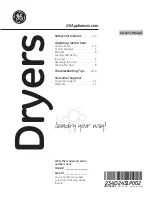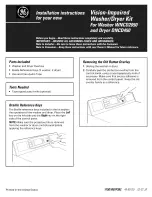
9
Calibration:
Turn the adjustment screw anticlockwise to increase the capacity and clockwise to decrease it.
A perfect dosage is obtained by turning the adjustment screw by approximately 90 degrees.
An excessive dose of surfactant leaves blue streaks on the crockery and leads to the formation of foam in
the bowl.
On the other hand, if crockery is covered with water droplets and drying is slow it means that the dose of
surfactant is insufficient.
Before setting the right amount of surfactant to be used, it is advisable to carry out a specific test to
determine the degree of water hardness.
If the hardness of the water is greater than 15°F. (French degrees), we advise to install a decalcifyer
upstream from the supply solenoid valve of the machine.
Considering that the amount of surfactant varies sensibly according to its concentration and type of
formulation, the values listed in this manual are totally indicative and must only serve as guidance.
The instructions supplied with the surfactant used will provide useful information on how to determine the
necessary dose.
In order to determine the exact amount of product, once the suction has been carried out, remove the
transparent tublet from the surfactant container and measure the shift in the internal column of liquid.
The doses shown have been calculated on the basis of the characteristics of a good product available on the
market (with a recommended concentration of 1.5g. per 10lt. of rinse water) and to a water hardness of 10-
12°F .
Given that 1g. of product (1cm³) is equal to 8 cm in the liquid column inside the transparent suction tublet,
the indicative amounts for the various models are as follows:
CONSUMPTION of H
2
O
RINSE (l)
AMOUNT OF PRODUCT
(cm)
SC40A
2.2
2.6
SC45A
SC45A WS
2.2
2.6
SC50A
3
3.6
10.2
LOADING THE DETERGENT
Pour the required amount of detergent into the dishwasher by following the instructions provided by the
manufacturer.
If powder detergent is used make sure that it is evenly distributed in the bowl and does not deposit on one
single area in order to avoid the formation of dark stains at the bottom; shake the water.
Considering that the dosage varies sensibly (0.8-2.5 grams/litre) according to the product concentration and
type of formulation, the amounts shown are purely indicative.
EXAMPLE OF DOSAGE WITH 2 g/litre
CAPACITY TUB (l.)
INITIAL DOSE
EVERY 5 WASH CYCLES
SC40A
8
16 g
7 g
SC45A
18
36 g
20 g
SC50A
23
46 g
23 g
Use only specific anti-foam detergents in the appropriate doses.
11. DISPENSER FOR LIQUID DETERGENT (optional)
11.1
START-UP
Before adjusting the detergent dispenser (optional), this and the corresponding small supply pipe must be
filled as follows:
Supply voltage to the machine.
The dispenser is connected in parallel with the load/rinse solenoid valve.
DO NOT insert the overflow in the drain hole and run the water until the small transparent plastic pipe and
the dispenser are filled.
Check the detergent concentration and the supply water hardness by referring to the product data sheet
before adjusting the dispenser.
Follow the manufacturer's instructions carefully.
Summary of Contents for SC40A
Page 1: ...INSTALLATION USE AND MAINTENANCE MANUAL GLASSES WASHERS FRONT LOADING DISH WASHER...
Page 21: ...21 Copper electric system PA Nylon wash circuit...
Page 22: ...22 21 INSTALLATION DIAGRAMS...
Page 23: ...23...
Page 24: ...24...










































